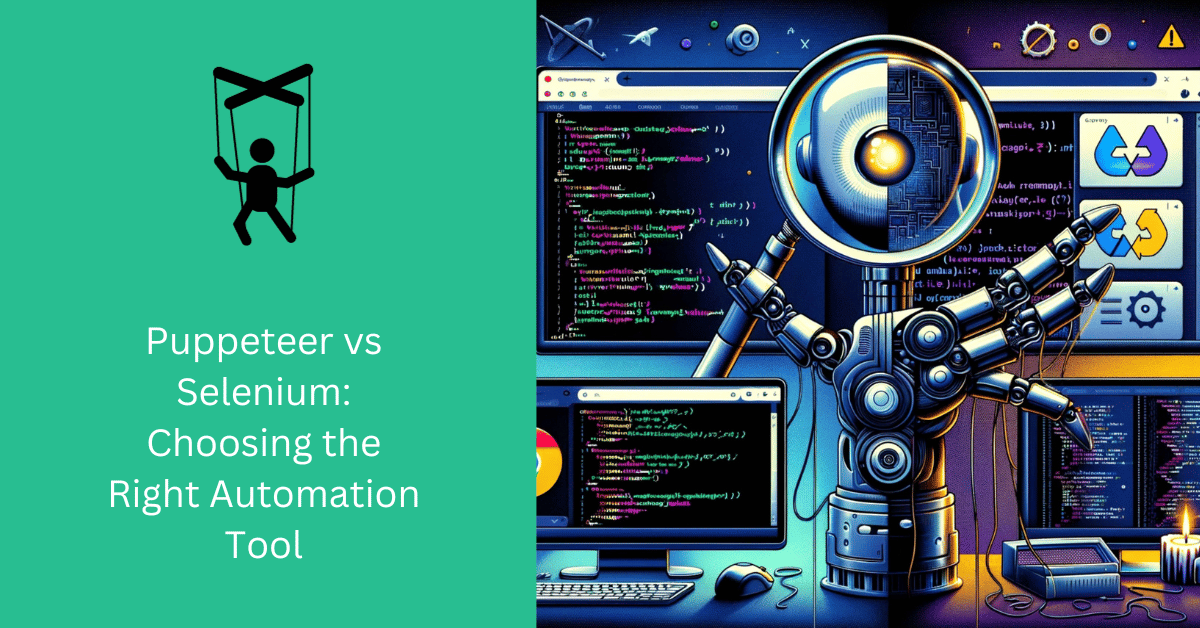
1. Origins and Focus
Puppeteer: Puppeteer, developed by Google, is a Node.js library and browser testing framework. It offers a high-level API for controlling headless Chrome via the DevTools Protocol. Puppeteer is tailored for Chrome, Chromium, and JavaScript, focusing on automation, web scraping, and performance testing.
Selenium: Selenium, initiated by Thoughtworks in 2004, comprises a collection of open-source tools for browser application testing. It covers a broad spectrum of browsers, including Chrome, Firefox, Safari, Internet Explorer, Edge, and Opera, and supports multiple languages. Selenium is dedicated to testing web applications.
2. Browser Support
Puppeteer: Puppeteer primarily targets Chrome and Chromium, not offering out-of-the-box support for multiple browsers.
Selenium: Selenium is designed for cross-browser testing, making it compatible with various browsers, which is its distinctive feature.
3. Performance Management
Puppeteer: Puppeteer excels in performance management, providing features like runtime and load performance recording, screenshot capture, and CPU performance throttling for simulating mobile device performance.
Selenium: Selenium does not offer the extensive performance management capabilities found in Puppeteer.
4. Ease of Use
Puppeteer: Puppeteer is coder-friendly for experienced JavaScript developers but lacks dedicated testing automation features found in Selenium. It does not provide an integrated development environment (IDE) for writing and managing test scripts.
Selenium: Selenium is a more complex solution due to its broad support for multiple browsers, languages, and platforms. Setting up Selenium WebDriver and Selenium Grid can be challenging. Selenium’s IDE facilitates script recording and editing, enhancing tester productivity.
5. Language and Learning Curve
Puppeteer: Puppeteer uses JavaScript, making it accessible for JavaScript developers. It is focused on Chrome automation but does not provide a comprehensive testing IDE.
Selenium: Selenium uses Selenese as the language for test script definition. It supports multiple languages, including JavaScript, Java, Ruby, C#, and Python, introducing a learning curve for developers.
6. Purpose
Puppeteer: Puppeteer is primarily aimed at automating Chrome and Chromium, focusing on automation, web scraping, and performance testing. It lacks dedicated testing features found in Selenium.
Selenium: Selenium is designed for web application testing, particularly on various browsers and platforms, making it ideal for cross-browser testing.
7. Installation Complexity
Puppeteer: Installing Puppeteer is straightforward using npm or Yarn, making it easily accessible for Node.js developers.
Selenium: Selenium installation is more intricate, involving configuration for specific modules, browsers, and languages, which can be more challenging compared to Puppeteer.
8. Geographic Restrictions and Data Scraping
Puppeteer: Puppeteer does not inherently address geographic restrictions. Integration with proxies can be used to overcome such limitations.
Selenium: Selenium can be integrated with proxy providers to bypass geographic restrictions and other obstacles set by websites, making it more versatile for web scraping.
9. Parallel Testing
Puppeteer: Puppeteer lacks built-in features for parallel testing on multiple machines.
Selenium: Selenium Grid allows the execution of WebDriver scripts on remote machines, enabling parallel testing across different browsers and platforms.
10. Extension Capabilities
Puppeteer: Puppeteer can be extended for additional capabilities, including data scraping, through integrations and third-party tools.
Selenium: Selenium is versatile and can support data scraping, offering robust automation capabilities.

Choosing the Right Fit
Web application testing is essential, and the choice between Puppeteer and Selenium depends on your specific needs. If your focus is primarily testing web applications on multiple browsers, Selenium is the better choice. It is designed for cross-platform testing. If you are exclusively dealing with Chrome and JavaScript, Puppeteer is a more suitable fit.
Regardless of your choice, consider Fineproxy’s Scraping Browser as a solution to streamline data collection efforts, saving time and resources. This automated scraping browser facilitates interactions using Puppeteer (Python), Playwright (Node.js), or Selenium.
Puppeteer vs Cypress
When deciding between Puppeteer and Cypress, it’s important to consider your specific testing needs and requirements. Both tools are valuable in their own right, but they have distinct characteristics. Here’s a comparison to help you choose the one that suits your project best:
Puppeteer
- Use Case:
Puppeteer is primarily designed for browser automation, web scraping, and headless Chrome control. It is not exclusively a testing tool but can be used for testing.
- Browser Control:
Puppeteer allows you to control and automate Chrome and Chromium browsers, making it an ideal choice if your testing and automation revolve around these browsers.
- Programming Language:
Puppeteer is a Node.js library and is best suited for developers familiar with JavaScript.
- Browser Interaction:
Puppeteer can simulate user interactions and navigate through web pages. It’s suitable for scenarios where you need to automate complex interactions with a headless browser.
- Performance Testing:
Puppeteer provides features for performance testing, such as recording runtime and load performance, capturing screenshots, and simulating mobile device performance.
- Scalability:
Puppeteer can be used for scraping, but if you need to scale up your testing, you may need to handle proxy integration and parallelization yourself.
Cypress
Use Case:
Cypress is specifically designed for end-to-end testing of web applications. It is a testing framework focused on ensuring the quality and functionality of web applications.
- Browser Control:
Cypress has its own browser automation engine that runs within Chromium. It is tightly integrated with this browser and designed for web application testing.
- Programming Language:
Cypress test scripts are written in JavaScript, but the tool provides a higher-level API specifically for testing, making it user-friendly for testers with limited coding experience.
- Browser Interaction:
Cypress excels at simulating user interactions with web applications, making it an excellent choice for end-to-end testing of web apps.
- Performance Testing:
While Cypress focuses on testing, it doesn’t provide the extensive performance testing features offered by Puppeteer.
- Scalability:
Cypress simplifies test parallelization and handles it seamlessly, making it a good choice for scaling up your testing efforts.
Which One to Choose:
- Choose Puppeteer if your primary use case includes web scraping, headless Chrome automation, or more complex interactions with the browser. If you’re comfortable with JavaScript and Node.js, Puppeteer can be a versatile choice.
- Choose Cypress if your main focus is end-to-end testing of web applications. Cypress offers a user-friendly approach to writing and managing tests and simplifies parallelization. It’s ideal for testers and developers who want to ensure the quality and functionality of web applications.
Ultimately, the choice between Puppeteer and Cypress depends on the nature of your project and the specific testing or automation tasks you need to accomplish. Each tool has its strengths, and the decision should align with your goals and expertise.






Comments (0)
There are no comments here yet, you can be the first!